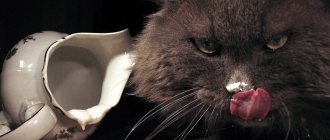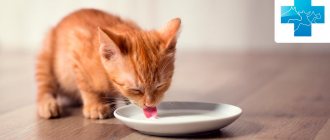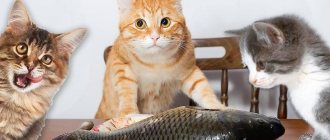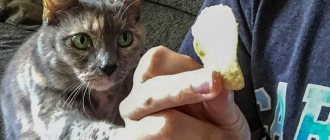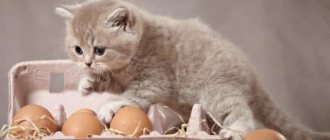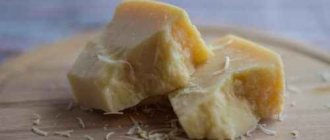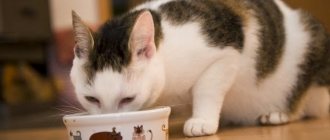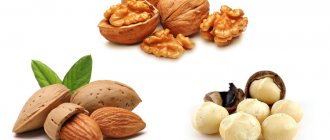The benefits and harms of dairy products for cats
Dairy products should be present in a cat's daily diet at any age. For kittens under 6 months of age, dairy products are essential in their diet. As for the diet of an adult pet, it should also contain dairy products. They must be natural. Milk made from chemicals will greatly harm your digestion.
Here are a few rules for giving basic fermented milk products::
- Kefir should stand for at least three days until the alcohol content disappears from it.
- The fat content of milk and cottage cheese for a cat should be no higher than 9%.
- It is not recommended to give cream to cats. This is a too fatty product, which will lead to digestive upset and, if consumed regularly, harms the liver.
- Milk in its pure form can be given to kittens. The older the cat gets, the worse lactose is digested. Therefore, it is advisable to give milk to adult cats only in rare cases.
- Sour cream. Recommended on rare occasions as a treat. A fatty product that leads to obesity and digestive pathologies.
To create a balanced diet, you should not include dairy products in your cat's daily diet. When choosing, you need to pay attention to the expiration date and fat content.
The cat has yellow diarrhea
global $ads_google; //data-ad-slot=”2475549904″ $ads_google = empty($ads_google) ? false : true; ?> if ($ads_google == false) {?>
$ads_google = true; ?> } ?>
Yellow diarrhea in a cat without signs of orange is considered normal, since bilirubin in bile is processed into brown stercobilin, and with loose stools, bilirubin may not be completely processed. But bright yellow or yellow-orange stools indicate jaundice or poor absorption of foods. Having analyzed the cat’s menu of the last few days, and noticing that there was a lot of milk, raw seafood, liver, and fatty meat, they urgently change the pet’s diet. If a half-starvation diet does not produce results, the cat is shown to a specialist.
How to treat
If the cause of yellow diarrhea in a cat is overfeeding or a reaction to new food, then you can do home treatment. But this can only be done if the cat’s condition does not cause concern. Home treatment consists of supervision - the cat’s condition must be kept under control, and the younger the pet, the more dangerous loose stools are. Dehydration can kill a kitten very quickly. Access to clean boiled water is required.
Since bilirubin is an aggressive substance, after each bowel movement you need to wash the dirty area around the anus with warm water and soap.
If yellow diarrhea is the result of overfeeding, then the cat is offered a tablespoon of pumpkin puree 2-3 times a day. You can use ready-made baby puree.
The benefits and harms of cottage cheese
You definitely need to give your cat cottage cheese. This is a useful product and its benefits include :
- The presence of microelements that are easily absorbed by the cat’s body.
- Cottage cheese normalizes the condition of the intestines and its microflora, protecting your furry pet from dysbacteriosis.
- Contains a large amount of vitamins and protein.
With proper feeding of cottage cheese, the cat's teeth and musculoskeletal system will develop normally. Cottage cheese contains large amounts of phosphorus and calcium. This product is well digested by the cat’s body even in old age. This is where cottage cheese compares favorably with kefir.
Before feeding your cat cottage cheese, you need to consider the possible harm.:
- An allergic reaction and indigestibility may occur.
- A product that is too fatty has a negative effect on the animal’s liver.
For a cat’s health, about a third of the diet should be fermented milk products. Cottage cheese is the most optimal option in terms of the ratio of harm and benefit. A very small amount is needed.
Rules for feeding your pet cottage cheese
In order for your cat to get the maximum benefit from eating cottage cheese, you need to follow a few simple rules. First of all, choose your cottage cheese carefully. It must have a normal expiration date and not be spoiled. It is forbidden to give sour cottage cheese to your pets. If you are not sure about the quality of a store-bought product, take a homemade one, you can’t go wrong.
When choosing, you need to pay attention to what exactly is in the package. It should be cottage cheese, not a curd product or sweet curd. These products are harmful to cats because they contain fragrances, various chemical additives and sugar. Everything sweet is a home for the cat's body.
You should not buy low-fat cottage cheese, as it will not be beneficial. Recommended fat content for cats is 9%.
To prevent an allergic reaction, it is recommended to start with minimal doses and monitor the pet’s condition. If diarrhea or poor health occurs, this product should be removed from the diet.
To fully provide your pet's body with calcium, it is enough to give the kitten cottage cheese 3-4 times a week . This will cover all the needs of a growing organism. For adult cats, the number of cottage cheese feedings is reduced to 1-2 times a week.
You can add egg yolk to the cottage cheese. This will make it a real treat for your cat. Protein cannot be added. You can give cottage cheese with sour cream. But then the product will turn out fattier and it is recommended to reduce its quantity.
Too fatty cottage cheese will lead to serious consequences in the form of chronic liver diseases and obesity.
Nutritional features of a castrated cat
Cats get used to a certain lifestyle, including feeding schedules. Any disruption to the usual course of events can cause them stress. Therefore, from an early age, if possible, it is necessary to accustom your pet to a certain style of feeding.
The following rules should be followed:
- You cannot feed natural food and prepared food at the same time. If a cat is accustomed to a natural diet, he can, of course, occasionally be pampered with ready-made food, but constantly giving two types of food is strictly prohibited. This is due to the fact that industrial feed contains the entire necessary set of nutrients, taking into account the age and individual characteristics of the animal. They are developed in such a way that the cat’s body receives everything it needs. If such food is mixed with natural products, there is a high risk that some nutrients will be deficient and others will be in excess.
- Cat food should be warm (but not hot).
- It is recommended to feed the cat 3-4 times a day. There must be a certain schedule that the animal will get used to. Although cats do not know how to use a watch, they clearly know the usual feeding time.
- The place where the cat eats must be permanent. It is advisable to choose a quiet corner where the animal will feel safe and no one will distract it from eating. If there are several pets in the house, then you need to make sure that they do not interfere with each other, and each of them can safely eat their food.
- If the cat has a natural diet, then after eating it is necessary to clear it “from the table”. Protein food gets exposed to air, loses its properties, and simply spoils. The diet should consist of 80% protein, since the cat’s gastrointestinal tract is adapted to digesting soft meat fibers and does not tolerate coarse plant fibers well.
- If a neutered cat is fed ready-made food, you should stick to one brand of food. The main diet should be dry food, wet food should be given less often, about once a day.
Cat food manufacturers that have proven themselves on the market usually produce special lines of food designed specifically for neutered cats. They have a reduced content of phosphorus, calcium and magnesium. You can also choose food designed for young or old animals with short or long hair.
Proper selection of food will help provide your pet’s body with all the necessary substances without causing harm to it.
Make cottage cheese yourself
In order not to take risks and not to buy a product of dubious quality, you can make cottage cheese for your cat yourself at home.
For one serving of cottage cheese you will need 250 ml. homemade milk. Add a small portion of kefir and place in a water bath. Thus, bring the milk to a boil. When the milk curdles and boils, wait a couple more minutes and strain through a sieve. The resulting mass is optional. Cats enjoy eating wet cottage cheese.
You can give milk and cottage cheese to cats, it is important in what quantity and what quality the products are. Adding fermented milk products to your daily diet is not recommended as it can cause intestinal upset. But high-quality cottage cheese a couple of times a week as a treat won’t even hurt.
Benefits and harms
A balanced diet for kittens must include cottage cheese. This product has the following beneficial properties:
- normalizes intestinal function;
- enriches with vitamins and large amounts of protein;
- easily absorbed by the body;
- helps strengthen bones and teeth;
- has a beneficial effect on wool growth and quality.
However, along with the benefits, cottage cheese can also cause harm to the kitten. Some pets experience an allergic reaction, with the baby becoming weak, rashes and itching of the skin, and discharge from the nose and eyes. In addition, the body may become intolerant of the product, resulting in diarrhea and vomiting. With high fat content, cottage cheese puts an increased load on the liver, which has a detrimental effect on the overall health of the animal.
Causes of diarrhea
Many owners do not consider diarrhea a dangerous symptom.
But in vain. After all, it can indicate dangerous diseases, and diarrhea itself in small kittens can lead to serious dehydration in just a day. To protect your pet, it is necessary to promptly determine the cause of diarrhea. Bacterial infection. It has a very high temperature. In this case, diarrhea has an unpleasant odor, the stool is liquid or even becomes watery, and often turns green. The pet feels unwell, refuses to eat, and is apathetic.
Viral infection. Such severe inflammation does not develop as with microbial infection. The temperature is also increased, but not so much. Although the pet is less mobile, it is active and does not refuse food. Feces are often yellow and mushy.
Worms. The kitten is quickly losing weight, feels unwell, the tummy is swollen and tense, and when palpated, lumps may be detected. There is a lot of mucus in stool, which is why it becomes gray in color and has a strong unpleasant odor. Often there is blood in the stool or it turns black. Sometimes the animal vomits, the vomit can be in the form of white foam, sometimes it contains live worms.
Allergy to food. In an allergic reaction, diarrhea occurs immediately after eating. An important distinguishing feature is a new product in the diet. Allergy stool is yellow and mushy. At the same time, other signs of allergies appear: dermatitis, hair loss, swelling, spot redness.
Food poisoning. It occurs among careless owners who do not know what to feed the kitten. When giving spoiled or unsuitable food to kittens, diarrhea is observed immediately after feeding, 2-3 hours later. The stool is mushy, yellow, defecation is observed 2-3 times in a row, but after cleansing the intestines everything stops. In case of serious poisoning, diarrhea does not stop on its own, the animal feels unwell, and may even vomit.
Stress. When buying a kitten, the new owner must understand that the pet is changing its place of residence and parting with its mother. All this is a powerful stress for the kitten. Therefore, diarrhea is a common occurrence. The difference between psychological diarrhea is the behavior of the pet. He often meows, calls his mother, hides in dark corners, and can behave aggressively.
Feeding disorder. Improper feeding may include a diet unbalanced in vitamins, proteins and microelements, violation of the feeding regime, overfeeding or underfeeding, and a rapid transition to adult food. The feces are yellow and mushy, the kitten feels well, plays, and has a healthy appetite.
Is it possible to give?
When creating a diet for both a kitten and an adult cat, it is important to include fermented milk products. The trace elements and nutrients they contain will ensure the normal growth and development of your pet. Thanks to the large amount of proteins, calcium and fluoride, the condition of the pet’s skeletal system will be fine. If you constantly give your kitten cottage cheese, muscle tissue will develop faster, and its teeth and claws will grow strong. As a rule, cats fed dairy products have thick, shiny fur and no problems with bowel movements.
Cottage cheese for kittens is the healthiest of fermented milk products, so it can not only be given, but also necessary.
Content
1. About the beneficial properties of cottage cheese 2. Dangerous properties of cottage cheese 3. How to give cottage cheese to a cat
Fermented milk products are useful not only for people, but also for pets. Everyone knows that they are rich in calcium, vitamins, microelements and have a beneficial effect on digestion and all body systems. But veterinarians say that not all dairy products can be included in pets’ diets, since lactose intolerance is common in adult cats. Then is it possible to give cottage cheese to a cat?
How to feed?
When taking care of the pet’s health and introducing cottage cheese into the menu, it is important for the owner to follow the following rules:
Sweet cheeses are contraindicated for fluffies.
- If kefir needs to be kept for three days before feeding, then only fresh cottage cheese is given.
- Before purchasing, you need to pay attention to the expiration date and composition. Various cottage cheese substitutes are not acceptable for kittens.
- You need to start feeding with a small amount, and it is important to monitor the pet’s condition. If diarrhea or feeling unwell occurs, the product should be removed from the diet.
- The fat content of cottage cheese should not exceed 9%. Otherwise, stomach upset, liver disease and obesity may develop.
- It is not recommended to feed your pet a low-fat product, as it will not bring any benefit.
- It is important to follow the serving dosage. The one-time dose should not exceed 30 g per day. The product should be given to kittens 3-4 times a week, and to an adult cat - twice every 7 days.
- You should not give various sweet cheeses and curds. They contain not only large amounts of sugar, but also various chemical additives. Flavorings and flavor enhancers act as poison on the animal's body.
If your pet does not eat cottage cheese, veterinarians recommend adding egg yolk to it. Kittens eat this dish with pleasure. Adding a small amount of sour cream will also improve the taste of the product. However, it should be remembered that in this case the fat content will increase, so the portion should be made smaller. It is not always possible to buy a quality product in a store. Therefore, to ensure the normal functioning of your pet, it is permissible to prepare cottage cheese yourself. To prepare, you will need to take 250 ml of milk, add 3 tbsp. l. kefir and place the mixture in a water bath. Then the composition must be brought to a boil. When the milk has curdled, you will need to strain the mixture through a sieve. This way you will get a high-quality and useful product.
When you mention feeding kittens, milk is certainly the first thing that comes to mind; even in childhood, we fed it to our own and barn kittens more than once and knew that it was healthy. What about other fermented milk products, for example, is it possible to give cottage cheese to a cat?
Features of choice
Pay attention to color and shape. The tail of a boiled-frozen shrimp is bent. This fact suggests that she was boiled alive. Shrimp heads should not be black. Dark color indicates late processing. Fresh catch is good for 4 hours. Therefore, it is subjected to chemical treatment. This increases shelf life and preserves its presentation. Animals' bodies are sensitive to chemicals. And it is unclear what consequences and after what time may appear.
As for sizes, small representatives are preferable. If you only accept king prawns, then they need to be chopped before serving. The animal simply cannot cope with the impressive crustaceans. Pets are unable to clean their food on their own. Give it in ready-to-use form. Some owners, with good intentions, offer "waste". Supposedly the product is expensive, but at least it gives you some pampering. This is absolutely impossible to do. The shell and heads of shrimp are prohibited; they are not absorbed by the body and can injure the mucous membranes of the mouth. Moreover, they are unlikely to be assimilated.
The benefits and harms of cottage cheese in the diet of cats
And so the fact that cottage cheese should be in a pet’s diet has already been decided.
What are the benefits of this product for the animal?:
- all macro- and microelements contained in high-quality cottage cheese are perfectly perceived by the cat’s body and are completely absorbed;
- Regular consumption of this fermented milk product normalizes intestinal function and eliminates the problem of dysbiosis;
- the building elements protein and calcium will normalize claws, fur, teeth and maintain the health of the musculoskeletal system.
What diseases can be treated?
The medicinal plant contains large quantities of complex nitrogen-free organic compounds called saponins, resin, vitamin K, tannins, and phytosterol. Therefore, pink immortelle has an excellent effect on the circulatory system, promoting faster clotting. Experts recommend using the plant for uterine or hemorrhoidal bleeding and hemoptysis. However, it is prohibited to determine the dosage yourself. This should only be done by a doctor.
The plant will help:
- very quickly and very effectively stop the flow of blood;
- use in gynecology implies the ability to normalize menstrual bleeding;
- remove stones formed in the bladder;
- cure the inflammatory process;
- improve visual ability;
- reduce the size of a malignant neoplasm;
- dilate blood vessels;
- relieve pain caused by gout;
- lower blood pressure;
- put the nervous system in order.
All parts of the plant located above the ground, including the stem, leaves and cap, have healing properties.
The medicinal plant contains large quantities of complex nitrogen-free organic compounds called saponins, resin, vitamin K, tannins, and phytosterol.
How to properly feed your pet cottage cheese
In order for feeding to be beneficial and help the kitten maintain its strength, you need to follow some rules.
- Product selection . It is this step that is the key to successful nutrition - you must select cottage cheese in the store with a valid expiration date; you should not skimp on the health of your “family member”. Feeding acidic foods is not allowed. If you have the slightest doubt about the quality of cottage cheese in the store, take homemade one, but of course from trusted suppliers.
- Substitutes . The use of “curd” derivatives is harmful for cats - curds, cheese curds and the like can kill the animal. The thing is that they are full of essences, flavor enhancers, stabilizers and of course sugar, which is generally considered poison for cats.
- Fat content . She also needs to be monitored. If the product is low-fat, then adding it to the diet is useless; if it is too fatty, it will put a strain on the gastrointestinal tract. The optimal fat content is 9%.
- Quantity . A kitten needs to introduce cottage cheese into its diet, just like a small child, in minimal doses. If even at the first attempts of administration there are negative manifestations on the face - diarrhea, weakness, etc., you should refuse to add it to the animal’s food.
A small kitten, since it is growing rapidly, should receive cottage cheese for food more often - 3-4 times a week. In an adult, the need for this product decreases; it is enough to eat it 1-2 times a week.
If you add the yolk of a chicken egg to the cottage cheese, you can really please your pet; it is a treat for them. It is also possible to add sour cream, but it is recommended to offer a smaller portion, because such a curd mass will be higher in calories and can threaten the cat with liver pathologies and sudden weight gain.
About the beneficial properties of cottage cheese
Since ancient times, cottage cheese was made from yogurt - sour milk, which was placed in a hot oven for several hours, then the whey was strained off. In this way, you can still make cottage cheese at home, except that the oven has been replaced by a gas stove.
Fermented milk product is known as a storehouse of protein, vitamins, and minerals needed by the body. Cottage cheese contains milk protein - casein, which has high nutritional value and can partially replace animal proteins. Cottage cheese is a source of amino acids, which are essential in the body, but are not produced by it independently, and therefore must be supplied with food.
The product contains 12 vitamins, the most valuable of which are B vitamins, as well as retinol (vitamin A), ascorbic acid (vitamin C), calciferol (vitamin D). All of them play an important role in metabolic processes, maintaining immunity and the normal functioning of all systems of the animal’s body. Vitamin A ensures good vision, which is especially important for cats that prefer a nocturnal lifestyle. In addition, kittens during the growth period and pregnant animals especially urgently need it. Vitamin A strengthens the immune system and has antioxidant properties. With a deficiency of retinol in the body, the functions of the digestive and reproductive systems are disrupted.
B vitamins have an effect on the digestive system, strengthen the body’s overall immunity, helping it cope with attacks from harmful bacteria and viruses. Vitamins of this group affect all vital processes of the body - they support the health of the heart and blood vessels, gastrointestinal tract, musculoskeletal and nervous systems.
Dangerous properties of cottage cheese
Cottage cheese is an acidic product, so it should not be given to cats suffering from gastritis and peptic ulcers. The product is not recommended for colitis and pancreatitis. A high protein component can provoke an exacerbation of kidney pathologies, so animals suffering from kidney failure should not be given even a drop of cottage cheese.
Due to the high fat content, frequent consumption of cottage cheese can cause an increase in cholesterol levels and weight gain, which entails a lot of negative consequences for the health of your pet.
